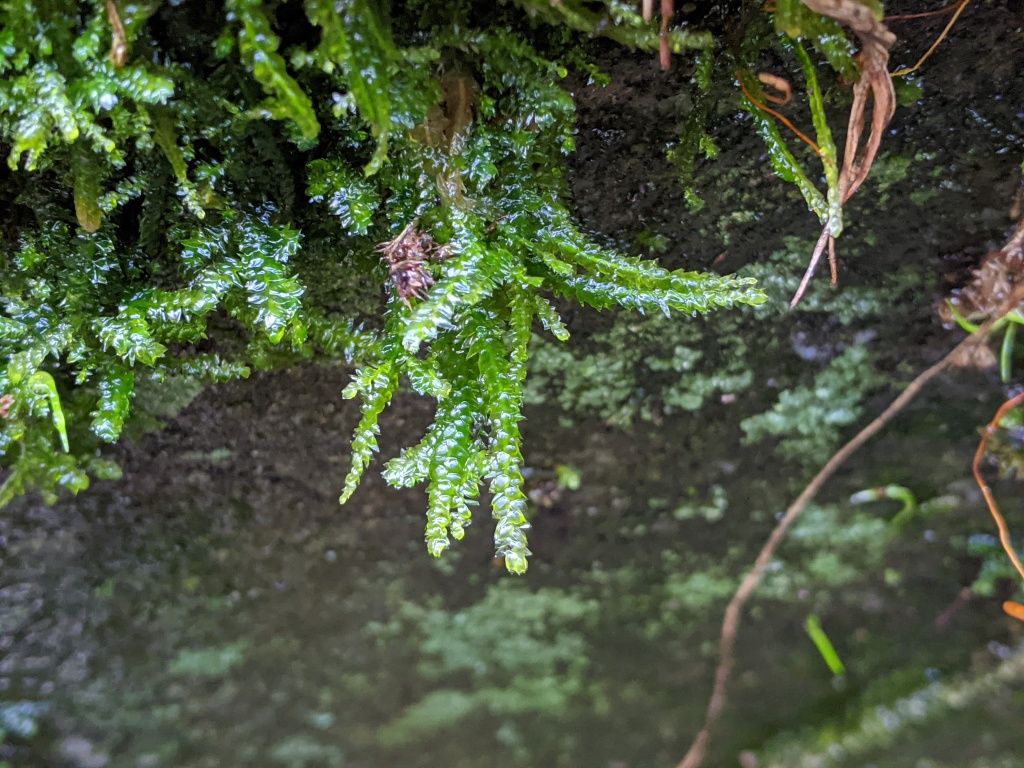Plagiotheciaceae
Autoicous or dioicous (not in Victoria). Asexual reproduction by cylindric to filamentous gemmae in leaf axils, or gemmae near stem apex (not in Victoria). Loose or dense mats or tufts (not in Victoria), often glossy, on rocks, logs, tree bases, tree ferns or soil. Stems creeping or erect (not in Victoria), simple or sparingly and irregularly branched, with easily detached branches, often with purple and papillose rhizoids in leaf axils; paraphyllia absent; pseudoparaphyllia absent; central strand present or absent. Leaves complanate or sometimes arranged around the stem and facing all directions, monomorphic or dimorphic and lateral leaves different shape to dorsal leaves (not in Victoria), symmetric or asymmetric, straight to falcate-secund, erect to squarrose when moist, scarcely altered when dry, decurrent or not at base; apex obtuse (not in Victoria), acute or acuminate, rarely piliferous (not in Victoria), sometimes bearing rhizoids (not in Victoria); costae short and double, sometime appearing single with one fork extending to around mid-leaf, or absent; margins entire, serrulate or serrate (not in Victoria), plane, revolute, or involute, without a distinct border; laminal cells mostly linear, rarely rhombic (not in Victoria) or subquadrate (not in Victoria), usually shorter at base, smooth, or rarely prorulose to papillose abaxially (not in Victoria); alar cells not differentiated or differentiated and elliptic or quadrate to rectangular, often inflated and hyaline. Pleurocarpous. Capsules erect to pendent, straight or curved, exserted, operculate, with an annulus. Operculum conic or rostrate. Calyptra cucullate, smooth, glabrous. Peristome double and alternate; exostome of 16 entire teeth, light whitish yellow; endostome of 16 segments, shorter than or almost as long as exostome teeth, with a low (not in Victoria) to high basal membrane; cilia present or absent (not in Victoria).
On all continents except Antarctica and with ten genera and around 125 species; two genera and species in Victoria.
The Victorian Isopterygiella was previously recognised in the Hypnaceae because it does not have decurrent leaf bases like Plagiothecium (e.g. Ramsay et al. 2012 as Isopterygiopsis). However, phylogenetic analyses of chloroplast, mitochondrial and nuclear sequence datasets place this genus as a close relative of Plagiothecium (Huttunen et al. 2013; Wynns et al. 2018; Ignatova et al. 2020) and consequently Isopterygiella is now generally placed within the Plagiotheciaceae (e.g. Goffinet et al. 2008). The Plagiotheciaceae are defined by a combination of an absence of paraphyllia and pseudoparaphyllia, easily detached branches, long-pored stomata in the capsule and a light whitish yellow exostome (Huttunen et al. 2013). Additionally, in many species the leaves are complanately arranged, with a double costa, and papillose and purplish rhizoids are often present in leaf axils (Huttunen et al. 2013).
 Spinning
SpinningGoffinet, B.; Buck, W.R.; Shaw, A.J. (2008). Morphology and classification of the Bryophyta, in Goffinet, B. & Shaw, A.J. (eds.), Bryophyte Biology 2nd edition, pp. 55–138. Cambridge University Press, Cambridge, UK.
Huttunen, S.; Ignatov, M.S.; Quandt, D.; Hedenäs, L. (2013). Phylogenetic position and delimitation of the moss family Plagiotheciaceae in the order Hypnales. Botanical Journal of the Linnean Society 171: 330–353.
Ignatova, E.A.; Fedorova, A.V.; Ignatov, M.S. (2020). On the genera Isopterygiopsis and Isopterygiella, gen. nov. (Plagiotheciaceae) in Russia. Arctoa 29: 49–62.
Ramsay, H.P. (2012). Australian Mosses Online 58. Hypnaceae: Isopterygiopsis. Version 17 July 2012. Australian Biological Resources Study, Canberra.
Wynns, J.T., Rysberg Munk, K., Asmussen Lange C.B. (2018). Molecular phylogeny of Plagiothecium and similar hypnalean mosses, with a revised sectional classification of Plagiothecium. Cladistics 34: 469–501.



